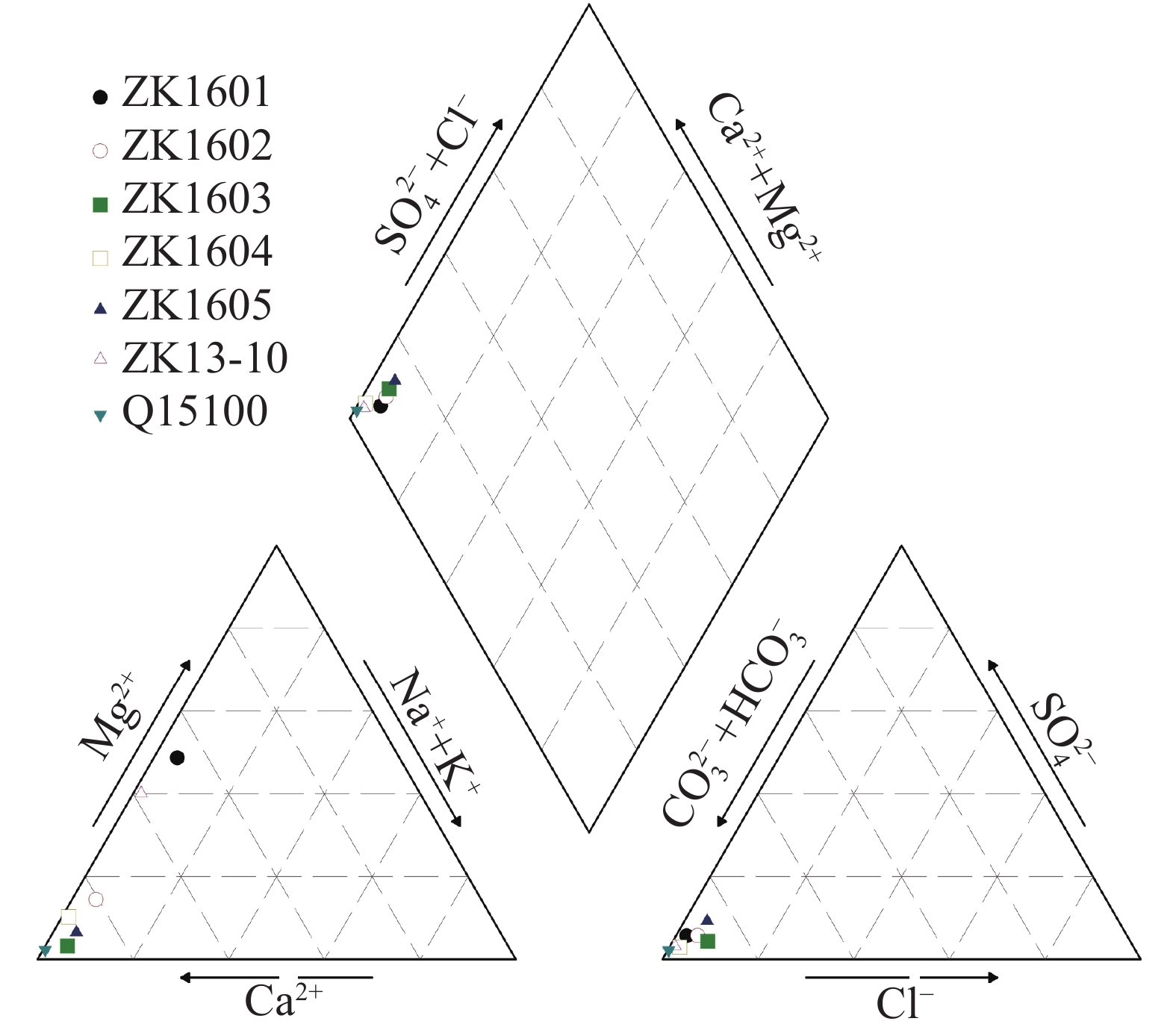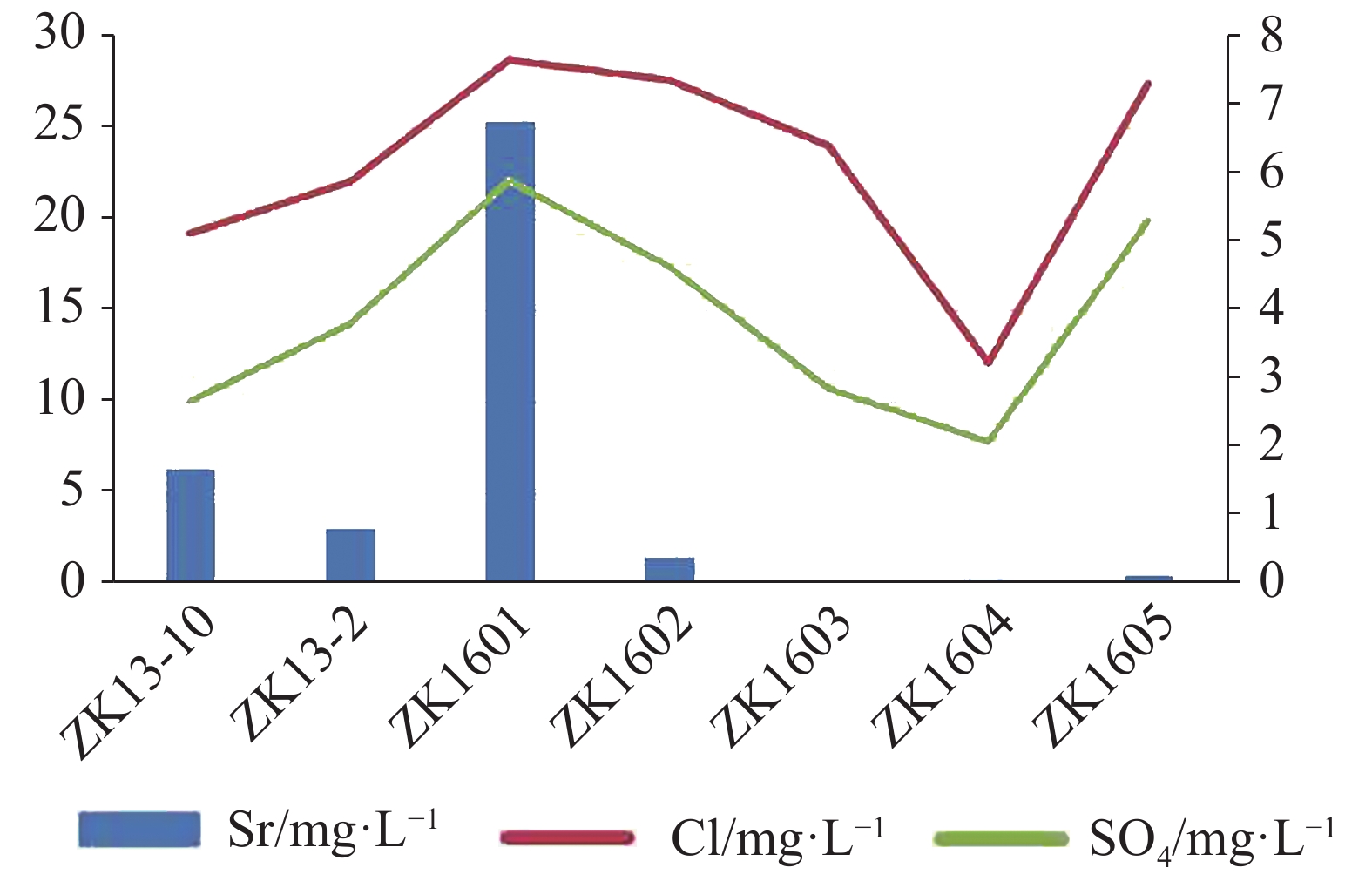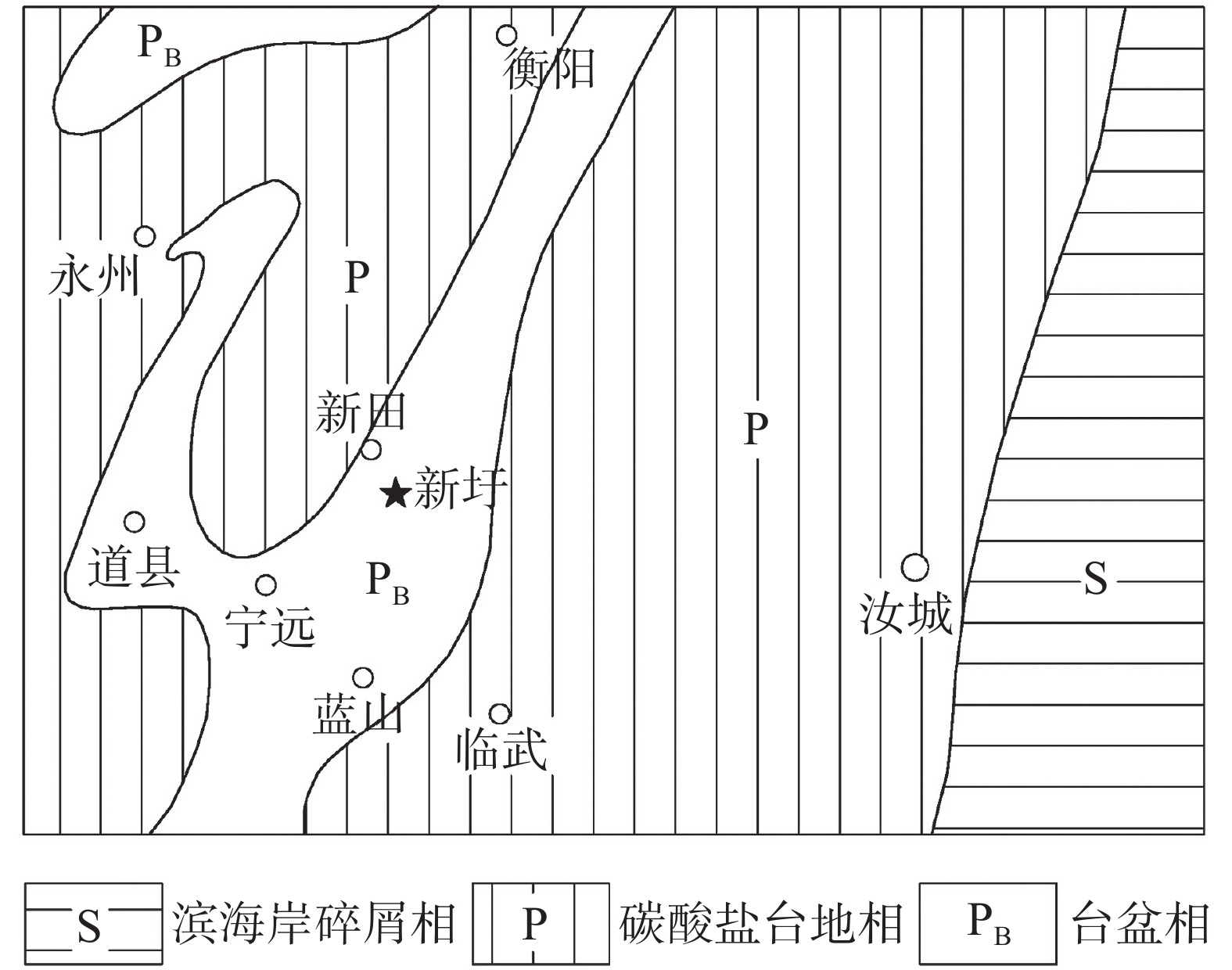Metallogenic regularity of strontium-rich drinking natural mineral water in Devonian carbonate area in southern Hunan: Taking strontium-rich drinking mineral water in Xinxu town, Xintian county as an example
-
摘要:
湘南地区泥盆系碳酸盐岩分布广泛,文章在分析湖南省新田县新圩富锶饮用天然矿泉水形成的岩性、构造、水文地质条件、水文地球化学成因的基础上,通过探究影响锶富集的因素,揭示出泥盆系碳酸盐岩分布区富锶饮用天然矿泉水的成矿规律:泥盆系佘田桥组泥灰岩中锶的高丰度、相对封闭的地下水循环交替条件和弱的水动力条件是形成富锶饮用天然矿泉水的根本条件,循环深度和水温是锶富集的重要影响因素。湘南地区台盆相佘田桥组泥灰岩分布区是寻找富锶饮用天然矿泉水的首选靶区,特别是平缓的溶丘岗地地区的阻水断裂上盘以及靠近岩浆岩岩体和区域导热断裂附近是寻找富锶饮用天然矿泉水的有利地段。
Abstract:The study area is located in Xinxu, Xintian county, the middle of southern Hunan, in which Devonian carbonate rocks are widely distributed in the south of N26°30'. 44 samples have been taken from some boreholes and springs in different lithologic distribution areas in different seasons for many years. The sampling sites are located in the marl distribution area of Shetianqiao formation of Devonian interplatform basin (D3s). Testing statistics of these samples show that the strontium content of groundwater in ZK13-10, ZK1601 and ZK1602 boreholes is 1.66 mg·L−1, 6.76 mg·L−1 and 0.41 mg·L−1 respectively, which can prove the existence of strontium-rich drinking natural mineral water.Based on the analysis of lithology, structure, hydrogeological conditions, hydrogeochemical origin and influencing factors of strontium enrichment, the metallogenic regularity of strontium-rich mineral spring water in Devonian carbonate distribution area is preliminarily revealed. According to the statistics of rock and mineral analysis and test results of 80 groups of rock cores at different depths of 5 boreholes, the average content of strontium in marl of Shetianqiao formation of Devonian interplatform basin (D3s) is 524×10−6, peaking at 800×0−6, much higher than that in other rocks.The high abundance of strontium is the material basis for the formation of strontium-rich mineral water in the study area. Primarily, the content variety of strontium in groundwater is closely related to groundwater circulation conditions. Three spots of strontium-rich groundwater in the study area mainly come from strontium-rich water in the zone of deep subsurface flow. High circulation depth, relatively closed groundwater circulation and weak hydrodynamic conditions are the main constraints for the formation of strontium-rich mineral spring. Because the groundwater recharge runoff is restricted by topographic and geomorphic conditions, seepage conditions, fault structure location and water control properties, the farther the distance of groundwater recharge runoff is, the higher the circulation depth will be, and in turn the more conducive will be to the enrichment of strontium and the formation of deep strontium-rich water. The water temperature is another important factor affecting the enrichment of strontium in groundwater because it affects the dissolution and ion replacement of minerals containing strontium, and it also affects the CO2 content and corrosiveness in groundwater, thus affecting the enrichment of strontium in groundwater. Meanwhile, the circulation depth and geothermal field will control the groundwater temperature.The metallogenic regularity of Xinxu strontium-rich drinking mineral water shows that the marl distribution area of Shetianqiao formation of Devonian interplatform basin (D3s) is a favorable area for people to look for the strontium-rich mineral spring in southern Hunan. In particular, the hanging wall of water-blocking faults in gentle karst hills as well as the location close to magmatic rocks and regional thermal conductivity faults are the target areas.
-

-
图 5 岩石、矿泉水中锶含量关系图(据刘庆宣等[2]修编)
Figure 5.
图 11 湘南泥盆纪岩相古地理略图(据刘文均[18]修编)
Figure 11.
表 1 研究区地层岩性表
Table 1. Stratum lithology in Xinxu
地层 符号 岩性 厚度/m 分布 泥盆系锡矿山组下段 D3x1 灰岩、白云质灰岩 72~436 研究区西部及南东角局部,出露面积0.56 km2 泥盆系佘田桥组 D3s 泥质灰岩、泥灰岩 551~915 研究区大部,新圩背斜翼部,出露面积16.69 km2 泥盆系棋梓桥组 D2q 厚层状生物碎屑灰岩 193~1048 研究区中部,分布面积12.86 km2,多被第四系覆盖 泥盆系跳马涧组 D2t 石英砂岩、含砾砂岩 165~588 研究区中部新圩背斜核部,无出露,仅在ZK1602孔被揭露 表 2 研究区水源点地下水水化学特征统计表
Table 2. Statistics of hydrochemical characteristics for groundwater in Xinxu
指标 单位 ZK13-10 ZK1601 ZK1602 ZK1603 ZK1604 ZK1605 Q15100 水温 ℃ 17.4 23.0 23.8 pH / 7.21 7.26 7.20 7.18 7.09 7.47 6.55 Sr mg·L−1 1.66 6.76 0.41 0.05 0.032 0.067 0.087 K+ mg·L−1 1.37 2.38 1.70 2.56 0.84 3.15 0.28 Na+ mg·L−1 2.84 10.60 8.90 5.05 1.74 3.30 0.50 Ca2+ mg·L−1 93.74 70.20 96.70 96.00 98.40 80.80 104.00 Mg2+ mg·L−1 39.07 44.60 10.50 2.02 6.88 3.60 1.50 Cl− mg·L−1 3.04 6.60 10.20 13.30 4.30 7.50 0.50 
mg·L−1 12.22 22.10 17.40 10.70 7.78 19.90 5.70 
mg·L−1 473 456 348 275 324 235 326 
mg·L−1 0 0 0 0 0 0 0 TDS mg·L−1 639 486 332 300 297 252 286 表 3 研究区钻孔岩石中Sr平均丰度与地下水中Sr含量表
Table 3. Average abundance of Sr in rock and in groundwater in Xinxu
地层 岩性 岩石中Sr含量/×10−6 地下水Sr含量/mg·L−1 样本数 范围值 平均丰度 D3s 泥灰岩 45 400~800 524 0.08~6.76 D2q 灰岩 26 100~400 239 0.03~0.13 D2t 石英砂岩 9 300~400 322 0.41 表 4 研究区富锶钻孔水文地质条件对比表
Table 4. Comparison of hydrogeological conditions of strontium-rich shafts in Xinxu
钻孔 Sr含量/mg·L−1 含水段深度/m 地下水补给径流循环条件对比 ZK1601 6.76 87.6~125 补给、径流区岩性为D3s泥灰岩,锶含量高;补给来源较远,径流距离较远;渗透系数为0.05 m·d−1,径流循环条件封闭;c(Cl−)/c(Ca2+)=0.053,水动力条件较弱;水温23 ℃相对较高,循环深度相对较大 ZK13-10 1.66 4.4~167.0 补给、径流区岩性为D3s泥灰岩,锶含量高;部分补给来源和径流距离较远,部分补给来源和径流距离近;渗透系数为0.158 m·d−1,径流循环条件相对较开放;c(Cl−)/c(Ca2+)=0.032,水动力条件相对较强;水温17.4 ℃正常,循环深度相对较小 ZK1602 0.41 232~296 补给、径流区岩性部分为D3s泥灰岩,部分为D2q灰岩和D2t石英砂岩,锶含量较低;补给来源较远,径流距离较远;渗透系数为0.27 m·d−1,径流循环条件相对较开放;c(Cl−)/c(Ca2+)=0.060,水动力条件较弱;水温23.8 ℃相对较高,循环深度相对较大 表 5 研究区达标水源点不同季节锶含量测试结果统计表
Table 5. Comparison of Sr2+ content in groundwater in different seasons
富锶机井 ZK13-10 ZK1602 测试日期/年.月.日 2014.5.29 2014.7.14 2016.4.11 2016.12.30 2016.8.15 2016.12.30 2017.1.10 2019.1.30 锶元素含量/mg·L-1 3.02 1.68 3.63 1.66 0.96 0.98 0.90 0.41 表 6 湘南泥盆系碳酸盐岩中Sr元素含量表(据刘文均[18]修编)
Table 6. Sr content in Devonian carbonate area in southern Hunan (modified according to Liu[18])
沉积相 层位 岩性 Sr含量范围值/×10−6 Sr含量平均值/×10−6 台地 局限台地(泻湖) D2q 白云岩 25.94~136.90 64.85 D3s 白云岩 27.47~123.80 77.13 局限台地(潮坪) D2q 灰岩 102.50~259.10 169.44 D3s 灰岩 66.65~370.40 185.09 开放台地 D3s 灰岩 179.40~404.90 297.31 台棚 D2q 泥质灰岩 143.00~523.70 303.40 D3s 泥质灰岩 196.10~402.10 300.78 盆缘斜坡 D3s 灰岩 214.20~1244.00 522.46 台盆 D3s 泥质灰岩 304.60~1158.00 769.72 -
[1] 周鑫, 刘勇, 郑鹏飞, 李杨, 戴济斌, 覃佐辉. 湖南省新田县新圩天然矿泉水勘查报告[R]. 长沙: 湖南省地质矿产勘查开发局四〇二队, 2019.
ZHOU Xin, LIU Yong, ZHENG Pengfei, LI Yang, DAI Jibin, QIN Zuohui. Exploration report of drinking natural mineral water in Xinxu, Xintian county, Hunan Province[R]. Changsha: 402 Geological Prospecting Party, 2019.
[2] 刘庆宣, 王贵玲, 张发旺. 矿泉水中微量元素锶富集的地球化学环境[J]. 水文地质工程地质, 2004, 33(6):19-23. doi: 10.3969/j.issn.1000-3665.2004.06.004
LIU Qingxuan, WANG Guiling, ZHANG Fawang. Geochemical environment of trace element strontium (Sr)enriched in mineral waters[J]. Hydrogeology & Engineering Geology, 2004, 33(6):19-23. doi: 10.3969/j.issn.1000-3665.2004.06.004
[3] 陈德生. 湘东南硅酸—锶矿水化学特征及形成条件[J]. 湖南地质, 1989, 8(2):46-50.
CHEN Desheng. Chemical feature of silica-strontium mineral water and their forming condition in southeastern Hunan[J]. Hunan Geology, 1989, 8(2):46-50.
[4] 朱雪芹, 刘文波, 李志明, 陈坦, 任玉祥, 邵海, 王龙凤. 承德地区天然含锶矿泉水空间分布及特征分析[J]. 水文地质工程地质, 2020, 47(6):65-73.
ZHU Xueqin, LIU Wenbo, LI Zhiming, CHEN Tan, REN Yuxiang, SHAO Hai, WANG Longfeng. Distribution and characterization analyses of strontium-bearing mineral spring water in the Chengde region[J]. Hydrogeology & Engineering Geology, 2020, 47(6):65-73.
[5] 苏春田, 黄晨晖, 邹胜章, 谢代兴, 赵光帅, 唐建生, 罗飞, 杨杨. 新田县地下水锶富集环境及来源分析[J]. 中国岩溶, 2017, 36(5):678-683.
SU Chuntian, HUANG Chenhui, ZOU Shengzhang, XIE Daixing, ZHAO Guangshuai, TANG Jiansheng, LUO Fei, YANG Yang. Enrichment environment and sources of strontium of groundwater in Xintian county, Hunan Province[J]. Carsologica Sinica, 2017, 36(5):678-683.
[6] 苏春田, 张发旺, 夏日元, 姚昕, 邹胜章, 罗飞, 赵光帅, 杨杨, 巴俊杰, 李小盼. 湖南新田发现大型富锶矿泉水及机理研究[J]. 中国地质, 2017, 44(5):1029-1030. doi: 10.12029/gc20170515
SU Chuntian, ZHANG Fawang, XIA Riyuan, YAO Xin, ZOU Shengzhang, LUO Fei, ZHAO Guangshuai, YANG Yang, BA Junjie, LI Xiaopan. A study of the water-rock interaction of large rich Sr mineral spring in Xintian, Hunan Province[J]. Geology in China, 2017, 44(5):1029-1030. doi: 10.12029/gc20170515
[7] 廖先远, 胡雨柔. 青海曲海天然饮用富锶型矿泉水形成机制分析[J]. 四川地质学报, 2017, 37(4):592-595. doi: 10.3969/j.issn.1006-0995.2017.04.014
LIAO Xianyuan, HU Yurou. Genetic Mechanism for the Sr-rich Mineral Water in Quhai, Qinghai[J]. Acta Geologica Sichuan, 2017, 37(4):592-595. doi: 10.3969/j.issn.1006-0995.2017.04.014
[8] 黄迅, 余泉. 婺源县冷水亭富锶矿泉水机理研究[J]. 中国高新科技, 2020(24):66-67.
HUANG Xun, YU Quan. Study on the mechanism of strontium-rich mineral water in Lengshuiting of Wuyuan County[J]. China High New Technology, 2020(24):66-67.
[9] 赵光帅, 苏春田, 潘晓东, 谢代兴, 罗飞, 杨杨, 巴俊杰, 李小盼, 毕奔腾. 湖南新田锶矿泉水水文地球化学分带特征分析[J]. 中国岩溶, 2019, 38(6):858-866.
ZHAO Guangshuai, SU Chuntian, PAN Xiaodong, XIE Daixing, LUO Fei, YANG Yang, BA Junjie, LI Xiaopan, BI Benteng. Hydrogeochemical zoning characteristics of the strontium mineral spring in Xintian county, Hunan Province[J]. Carsologica Sinica, 2019, 38(6):858-866.
[10] 许佩瑶, 丁志农. 含锶饮用天然矿泉水的形成[J]. 勘察科学技术, 1997(5):36-38.
XU Peiyao, DING Zhinong. Formation of potable natural mineral spring water containing strontium[J]. Site Investigation Science and Technology, 1997(5):36-38.
[11] 王宇. 岩溶高原地下水径流系统垂向分带[J]. 中国岩溶, 2018, 37(1):1-8.
WANG Yu. Vertical zoning of groundwater runoff system in karst plateau[J]. Carsologica Sinica, 2018, 37(1):1-8.
[12] 王大纯, 张人权, 史毅虹, 许绍倬. 水文地质学基础[M]. 北京: 地质出版社, 1995.
WANG Dachun, ZHANG Requan, SHI Yihong, XU shaozhuo. General Hydrogeology[M]. Beijing: Geological Publishing House, 1995.
[13] 袁道先, 蒋勇军, 沈立成, 蒲俊兵, 肖琼. 现代岩溶学[M]. 北京: 科学出版社, 2016.
YUAN Daoxian, JIANG Yongjun, SHEN Licheng, PU junbing, XIAO Qiong. Modern karstology[M]. Beijing: Science Press, 2016.
[14] 苏春田, 聂发运, 邹胜章, 赵光帅, 罗飞, 黄奇波, 巴俊杰, 李小盼, 梁嘉鹏, 杨杨. 湖南新田富锶地下水水化学特征与成因分析[J]. 现代地质, 2018, 32(3):554-564.
SU Chuntian, NIE Fayun, ZOU Shengzhang, ZHAO Guangshuai, LUO Fei, HUANG Qibo, BA Junjie, LI Xiaopan, LIANG Jiapeng, YANG Yang. Hydrochemical Characteristics and Formation Mechanism of Strontium-rich Groundwater in Xintian County, Hunan Province[J]. Geoscience, 2018, 32(3):554-564.
[15] 苏春田, 杨杨, 巴俊杰, 罗飞, 李小盼, 赵光帅. 新田县富锶地下水动态特点与成因分析[J]. 中国岩溶, 2020, 39(1):24-33.
SU Chuntian, YANG Yang, BA Junjie, LUO Fei, LI Xiaopan, ZHAO Guangshuai. Dynamic characteristics and genesis of strontium-rich groundwater in Xintian county, Hunan Province[J]. Carsologica Sinica, 2020, 39(1):24-33.
[16] 王蕾, 肖长来, 梁秀娟, 姜薇, 闫佰忠, 李树, 王悦刚. CO2对矿泉水中Sr2+、SiO2形成过程的影响实验研究:以靖宇县为例[J]. 节水灌溉, 2013(10):41-43. doi: 10.3969/j.issn.1007-4929.2013.10.013
WANG Lei, XIAO Changlai, LIANG Xiujuan, JIANG Wei, YAN Baizhong, LI Shu, WANG Yuegang. Experimental study on the effect of CO2 on the formation of Sr2+ and SiO2 in mineral water-A case study of Jingyu County[J]. Water Saving Irrigation, 2013(10):41-43. doi: 10.3969/j.issn.1007-4929.2013.10.013
[17] 闫志为, 刘辉利, 张志卫. 温度及CO2对方解石、白云石溶解度影响及特征分析[J]. 中国岩溶, 2009, 28(1):7-10. doi: 10.3969/j.issn.1001-4810.2009.01.002
YAN Zhiwei, LIU Huili, ZHANG Zhiwei. Influences of temperature and CO2 on the solubility of calcite and dolomite[J]. Carsologica Sinica, 2009, 28(1):7-10. doi: 10.3969/j.issn.1001-4810.2009.01.002
[18] 刘文均. 湘南泥盆纪碳酸盐岩中锶的分布特点及其环境意义[J]. 沉积学报, 1989, 7(2):14-20.
LIU Wenjun. The distributive characters and environmental signeficance of strontium in carbonate rocks of devonean in southern Hunan[J]. Acta Sedimentologica Sinica, 1989, 7(2):14-20.
[19] 蒋德和. 湘南中晚泥盆世台盆沉积特征及其演化[J]. 岩相古地理, 1990(6):21-29.
JIANG Dehe. Sedimentary characteristics and evolution of middle and late Devonian platform basins in southern Hunan[J]. Sedimentary Facies and Palaeogeography, 1990(6):21-29.
[20] 黄树春,夏友.湖南省矿泉水资源调查及其开发利用评价报告[R].长沙:湖南省地质环境监测总站,2015.
HUANG Shuchun, XIA You. Mineral water resources investigation and development and utilization evaluation report in Hunan Province[R]. Changsha: Hunan Geological Environment Monitoring Station,2015.
[21] 龙西亭, 皮景, 姚腾飞. 湖南省地下热水资源[M]. 武汉: 中国地质大学出版社, 2019.
LONG Xiting, PI Jing, YAO Tengfei. Geothermal water resources in Hunan Province[M]. Wuhan: China University of Geosciences Press, 2019.
-




 下载:
下载:









